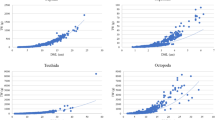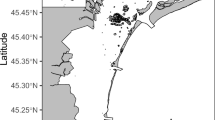Abstract
IN 1927 a method was devised by which living aquatic organisms can be weighed without removing them from their environment. Two accounts of the method were published in 19381,2, but a much fuller account of the technique was published in 19423 and 19434. In outline the method is very simple since, in the case of a marine animal such as a prawn, it consists of placing it in a suitable density bottle which is otherwise full of sea water and weighing the whole. The exact volume of the bottle and the density of the sea water are readily obtainable, and it is then only necessary to know the exact volume of the prawn to ascertain its weight.
This is a preview of subscription content, access via your institution
Access options
Subscribe to this journal
Receive 51 print issues and online access
$199.00 per year
only $3.90 per issue
Buy this article
- Purchase on SpringerLink
- Instant access to full article PDF
Prices may be subject to local taxes which are calculated during checkout
Similar content being viewed by others
References
Nature, 141, 289 (1938).
Lowndes, Proc. Linn. Soc., London, 150, Pt. 2 (1937–38).
Lowndes, J. Mar. Biol. Assoc., 25, No. 3, 555 (1942).
Lowndes, Proc. Zool. Soc. London, A, 113, 28 (1943).
Nature, 150, 695 (1942).
Thompson, Sir, D'Arcy, "Growth and Form", 67 (Cambridge, 1942).
Rights and permissions
About this article
Cite this article
LOWNDES, A. The Displacement Method of Weighing Living Quatic Organisms. Nature 155, 520–521 (1945). https://doi.org/10.1038/155520a0
Issue date:
DOI: https://doi.org/10.1038/155520a0



